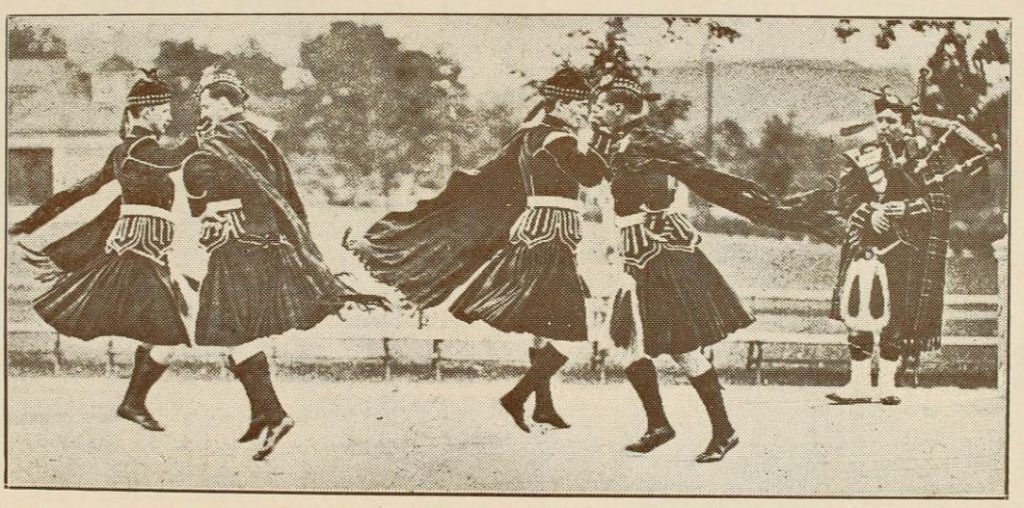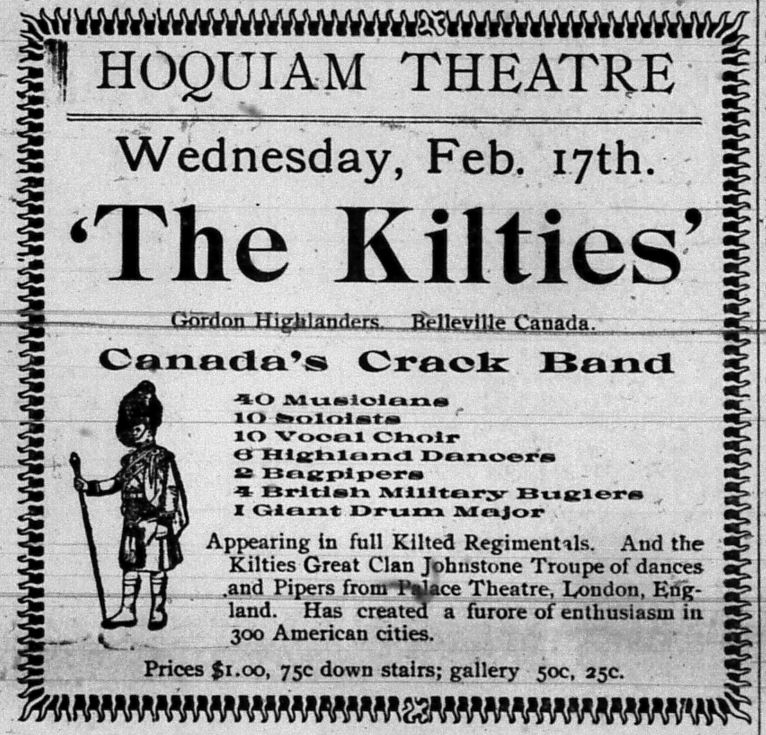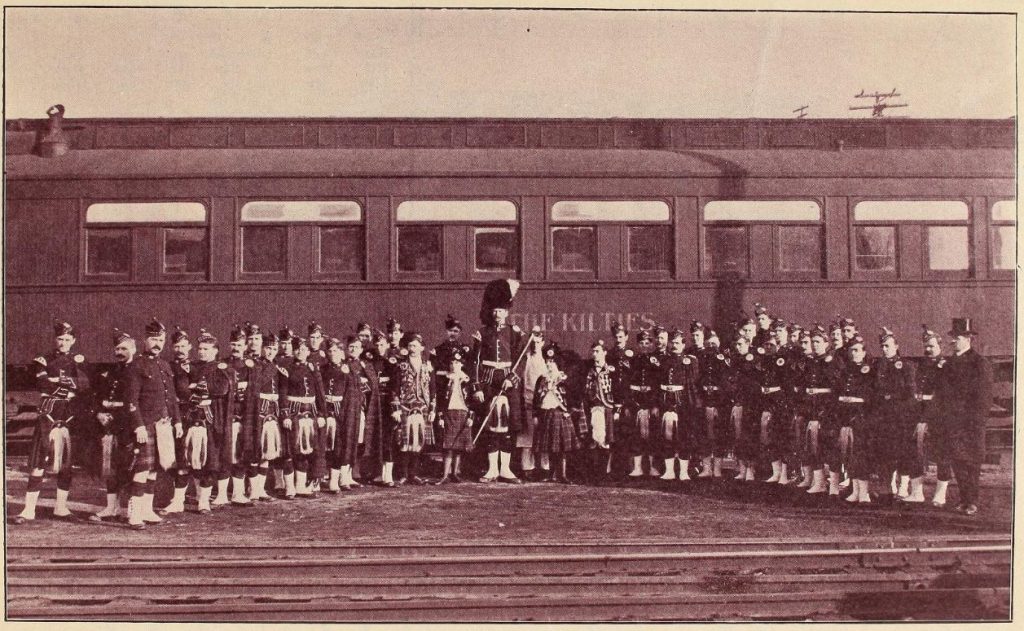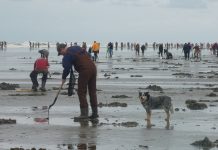Grays Harbor County has a rich Scottish heritage. In the early 1900s it welcomed two noted bands of Scottish musicians: the world-famous Canadian Kilties and the all-female Lady Kilties.

Scottish Immigrants in Grays Harbor
Scottish immigrants and their descendants were part of the massive wave of newcomers who came to Grays Harbor County in the mid and late 19th century. Aberdeen was even likely named for Aberdeen, Scotland.
One way Scottish people like to celebrate their culture is through music. It was the same at the turn of the century. To entertain their many Scottish members in November 1907, Reverand Charles McDermoth and his wife hosted a “most pleasant bagpipe social” at their home for the young people of the Aberdeen Congregational Church. In May 1901 W.G. McLeod of Tacoma, dressed in Highland costume, played the bagpipes at a “Scotch entertainment” hosted by the ladies of the First Presbyterian Church at the Congregational Church in Aberdeen. Local singers sang Scottish folk songs and Rev. Robert Arkley of Centralia gave an address on “Scottish Wit and Humor.”
But the greatest excitement was when performers came from Scotland. In March 1912 the Royal Theater company from Glasgow, Scotland appeared at the Grand Theater in Aberdeen to perform “Rob Roy,” based on Sir Walter Scott’s novel about the famous Scottish outlaw and folk hero. William McKay, “the world’s champion Scottish dancer,” performed.
Kilties Come to Grays Harbor, 1904
Perhaps the most famous Scottish band to visit Grays Harbor County was the Kilties. Hailing from Belleville, Canada, they performed at the Hoquiam Theater on Wednesday, February 17, 1904. The group was made up of veterans from the Gordon Highlanders, a Scottish military unit. “It is worth traveling a thousand miles” to hear them, the Hoquiam Washingtonian declared. They toured around the world, playing at the St. Louis World’s Fair and even performed for King Edward VII at Balmoral, the British Royal family’s Scottish castle in Aberdeenshire.
Tickets, available at Paine’s Drugstore, cost a dollar or 75 cents for downstairs seats and 50 cents or 25 cents for the gallery. The steamer Fleetwood was charted to bring people from out of town. 50 people came from Cosmopolis alone to hear “the greatest Scottish band in the world.”

“Canada’s crack band” was on a West Coast tour. It consisted of 40 musicians, 10 soloists, 10 vocal choir members, 6 Highland dancers, 2 bagpipers, 4 British military buglers and one very tall “giant drum major.”
Part of this group was the Clan Johnstone Troupe dancers and pipers from London’s Palace Theater. They were led by Albert Johnstone, called by some the “world’s first piping superstar.” Born in 1864 in Lochee to a blacksmithing family, Johnstone became a master bagpiper. He played for Queen Victoria and even at the Paris World’s Fair in 1889 and joined the Kilties on their world tour. Cissie Grant was the principal female dancer.
There is not a list of the Kilties’ local program, but their souvenir booklet, “Songs and Marches of ‘Auld Scotia,” give an idea of what they typically played: regimental march of the Gordon Highlanders “The Cock O’The North,” “The Brae’s O’Mar,” “Scots Wha Hae,” “Loch Lomond,” “Jock O’Hazeldean,” “The Kilties March” by Albert Johnstone, “The British Grenadiers,” “The Maple Leaf,” “Pibroch of Donuil Dhu,” “The Campbells are Comin’,” “Annie Lauire,” and “Auld Lange Syne.”

Lady Kilties Band in Grays Harbor, 1913
In 1913, Grays Harbor was visited by another notable Scottish musical group the Lady Kilties Band on their West Coast tour. Sometimes called the Ladies’ Kilties band, this Ottawa-based military concert band was not directly related to the Kilties described above. They were a brass band with a saxophone quartet and no bagpipers. The group did however have “Frankie” Tice, “the world’s premiere trombone soloist.”
The only male member of the Lady Kilties was William A. Dougall, conductor and director. He told reporters that he learned how “twenty-six bandsfolk should play Highland music by a leader of the Scotch Grays,” a historic Scottish military unit, “while many of the members of the organization learned the soul-stirring music of the dear old tunes while roaming through the fens and dales of the merry land across the waters.”
The Lady Kilties played at the Novelty Theater in Hoquiam on Wednesday, November 5. Tickets could be purchased at Gillett’s Drug Store and cost 25 cents, 75 cents or a $1, depending on the seat. Aberdeen High School’s football team got in free as guests of the management. The show started at 3 p.m.
The “most famous ladies’ band in the world” of “bonnie Scotch lassies” in “regulation Scotch cut” kilts and “striking” green caps, played mostly American songs rather than music “from the land of heather.” They opened with “Pride of the Regiment” March and the Overture from “Mazeppa.” The “Kimball Sisters” Enid and Wao from Oregon gave a cornet duet, “Swiss Boy.” The band then played a selection from Verdi’s “Il Trovatore” and a medley of Harry Lauder’s Scottish songs, “Auld Scotia.”
After a “Medley of Popular Hits” and the idyll “Hills in the Forest,” Hattie Heath performed the Highland Fling. The Lady Kilties wrapped up the concert with melodies from “Bohemian Girl,” a medley of Southern music called “Southern Stars,” and ended with the “Star Spangled Banner.”
Grays Harbor’s Scottish Legacy
Although the concerts of the Kilties and the Lady Kilties happened over a hundred years ago, Scottish heritage remains strong in Grays Harbor County. The two bands would be proud.











































